Roman Goadby
The first Roman invasion of Britain was by Julius Caesar in 55 to 54 BC. However, despite initially inflicting defeats on the British tribes, Caesar quickly established trading and treaty relationships with the native Celts, including the Corieltauvi tribe in the East Midlands area. Having made peace with his opponents Caesar returned to Gaul. It was not until a century later, under the Emperor Claudius, that the Romans returned to Britain with a force of four legions and changed the landscape forever. They built an effective road structure, military forts and settlements, and made Britain into one of the wealthiest and most valuable provinces in the Roman Empire. The Romans remained in Britain for nearly 400 years, from 43 AD until the last troops left to defend a beleaguered Rome in 410 AD.
The village of Goadby Marwood is located close to the ancient trackway known as ‘The Salt Way’ and is thought to be the site of a Romano-British small town that may have national importance as a key location in the East Midlands area. It is possible that the site played a significant role in local and regional socio-economic relationships, both before and during the Roman occupation. Over the last 70 years or so, a number of discoveries have led experts to conclude that the area was an important iron working location with possible links to the Roman towns of Vernemetum (near Willoughby on the Wolds) and Margidunum (near Bingham) on The Fosse Way.
Unfortunately, much of the site was destroyed in the 1950s by ironstone quarrying operations. On the right is an OS map from the mid-1950s which shows the position of the the ironstone quarry. The locations of various notable Roman discoveries in and around Goadby Marwood are marked.

Excerpt from Roman Small Towns in Leicestershire and Rutland
By Peter Liddle, 1995
Goadby Marwood (Eaton parish) (Roman name unknown)
This site was first noted in 1952 during ironstone quarrying. It was partly recorded by Mr Eli Coy, the quarry manager, who noted ‘signs of buildings’ (mostly stones), a ‘plaster floor ... similar to concrete’ (presumably opus signinum), a north-south cobbled road, an old quarry and twelve stone-lined wells. Four of these are in a southwest to northeast line and six in a southeast to northwest line and they almost certainly relate to buildings fronting the main roads through the site. ‘Numerous shallow pits, roughly oval in shape [which] contained calcined stone and slag from the smelting of ironstone’ were found in topsoil clearing and are clearly Roman bowl furnaces. Many skeletons were noted in the southern part of the site (partly published in Abbott 1956). Since 1982 metal detecting over the back-filled quarry has produced hundreds of Roman coins (of which well over a hundred have been identified at the Jewry Wall Museum), one Corieltauvian stater, over sixty brooches and many small finds. These include finger rings, belt fittings, dice, leather working stamps, spoons, keys, knives, bracelets, seal boxes, pendants, pins, weights etc. There is also a figurine of Mercury and a votive axe hinting at a religious dimension. Recent fieldwork has shown that the site extends to the northwest and that an ‘island’ of surviving archaeology exists between old quarries.
The quarry finds mentioned above are covered in detail by Robert Abbott in his paper, Roman Discoveries at Goadby Marwood, published by the Leicestershire Archaeological and Historical Society. At the time, all the finds were transferred to Leicester Museum but many can now be viewed at Melton Carnegie Museum.
Excerpt from Roman Discoveries at Goadby Marwood
By Robert Abbott, 1956
Structurally the most important features revealed were eleven wells sunk deep into the ironstone. Four of these (A, B, C, D on plan, Fig. 2) were found before the nature of the site was realised and were not examined, but the other seven ranged in depth from 9 ft. to 21 ft. With one exception these shafts were extremely well built, the upper 4-5 ft. being constructed of carefully dressed blocks of limestone and ironstone to form a circular flue shaped opening. Below this depth the sides belled out to form a vertical sided chamber going down through the rock. The entrance to the shafts varied in diameter from I ft. 9 in. to 3 ft. 6 in.
As has been noted previously, burial No. 6 [VI] was accompanied by a single ear-ring consisting of a split loop of bronze wire, 0.002m. in diameter, from which was suspended a small pendant terminating in a tiny facetted bead of blue paste (Fig. 4). A bracelet made from a single piece of bronze, circular in shape and with an opening, was also found with this burial.
Two brooches of late date have been found as stray finds; both are of disc type, one in the shape of an eight-pointed star with a recessed centre, and the other, an oval inset with a large crystal of black glass (Fig. 4).
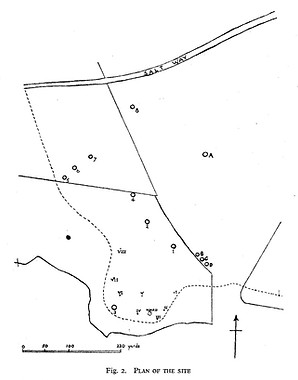
Plan of the quarry site finds from Abbott's Roman
Discoveries at Goadby Marwood showing the position
of the stone-lined wells and burials.
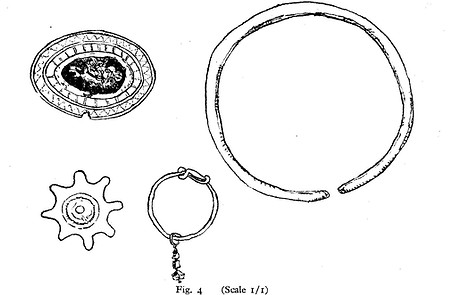
The bronze bracelet and the larger of the two brooches (left) referred to by Abbott can be viewed at Melton Carnegie Museum. The smaller brooch and the earing are still held at Leicester.
To see more of the Roman artefacts found in and around Goadby and held at the Carnegie Museum visit our Roman Finds page.
Read Robert Abbott's full report into the ironstone quarry finds of 1952 - 53.
The Roman Coin Hoard
In February 1953, an excavator clearing ground on the ironstone workings to the north of Goadby Marwood Hall, shattered a pottery urn that turned out to contain a very large cache of Roman coins.
Robert Abbott wrote an account of the findings for the Leicestershire Archaeological and Historical Society and made a detailed comparison of the coin hoard with other similar local finds at Lutterworth, at Mount St Bernard Abbey, and at Jewry Wall in Leicester.
Excerpt from Roman Discoveries at Goadby Marwood
By Robert Abbott, 1956
Whilst the writer was present on 20 February 1953, the bucket of the excavator clearing the top-soil from the southern extremity of the site struck the lower half of a grey-ware urn. The pot was shattered and the mass of coins which it contained was scattered over a wide area. With the cooperation of the workmen it was possible to recover 1,917 coins, which must have constituted the greater part of the hoard.
From the overwhelming predominance of the issues of the Tetrici [coins from the reigns of Tetricus I and Tetricus II - leaders of the Gallic Empire from 267 to 263] in the hoards from the Jewry Wall and from Goadby Marwood, it seems that both these hoards are several years later in date than those already discussed [Lutterworth and Mount St Bernard]. The latest coins in these two hoards are of Probus [Roman Emperor from 276 to 282] and it is suggested that a date c. 280 is appropriate for their concealment.
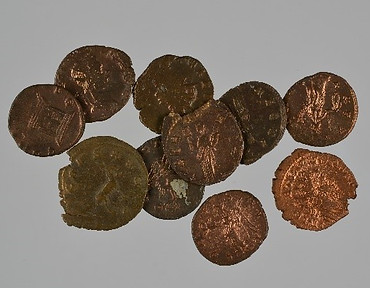
Coins from the Roman hoard discovered during quarrying operations in 1953.
The hoard can be viewed at Melton Carnegie Museum.
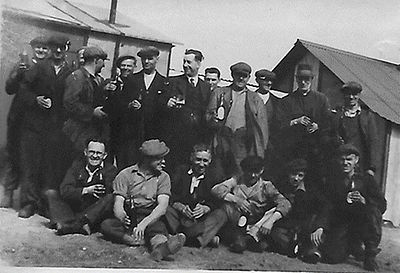
Quarry Manager Eli Coy is pictured centre holding a mug of beer.
Following the discovery of the coin hoard, quarry site manager, Eli Coy, retained a small number of the coins from the hoard to which he added a number of other coins discovered on various parts of the site. In 2018, our colleagues from The Field Detectives carried out an in-depth study of Eli’s collection, held by his grandsons, Beauford and Alan Linley.
Read the full account of The Field Detectives extensive research into the collection in their booklet: The Eli Coy Romano-British Coin Collection.
The Roman Villa
The hill to the south, overlooking the village, is the site of a Romano-British villa complex and a number of archaeological surveys and digs have been carried out at the location over the last several decades.
In 1985, local archaeology group, The Melton Fieldwalkers, carried out a resistivity survey and extensive examination of the surface of the site. In their report they noted that around 1970 the landowner had grubbed out stone walls which at that time stood to a height of about two feet, with subsequent ploughing causing further damage.
The survey resulted in numerous finds including pottery sherds, mosaic tesserae, and coins. Originally sent to Leicester for identification, many of the finds can now be viewed at Melton Carnegie Museum.
Read the full survey report published by The Leicestershire Archaeological and Historical Society:
During 2002, the Framland Local Archaeology Group (FLAG) undertook another resistivity survey in the area of the villa. The survey was done in 20m squares and covered an area measuring 100m east–west and 140m north–south. The results clearly showed the position of villa walls.
Following the survey, a number of trenches were excavated.
Excerpt from the Framland Local Archaeology Group Survey Report
Finds and information recovered from the site indicate that a large villa, probably of courtyard or winged-corridor type, once stood on the hillside overlooking the Romano-British ‘small town’ on the outskirts of what is today the village of Goadby Marwood. The walling uncovered on the whole survived in good condition: it is clear that wholesale robbing of the villa down to foundations has not occurred, at least in this part of the site, and that damage from ploughing, while severe, had still left most of the wall foundations intact. The finds suggest that the villa site had been occupied probably from the late first century and that it flourished during both the second and the third century; whether that continued into the fourth century is at present uncertain. The excavation by the FLAG team of the probable bathhouse is a significant step in the understanding of how the landscape was developed and managed.
Read the full survey findings in the Newsletter of the Leicestershire and Rutland Archaeological Network:
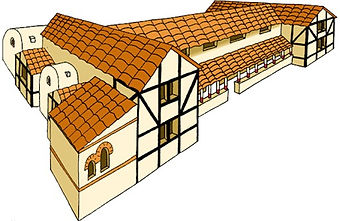
A typical winged-corridor villa of the type that may once have overlooked the Romano-British small town at Goadby Marwood.
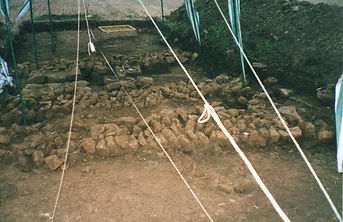
Villa walls exposed during the FLAG dig in 2004.
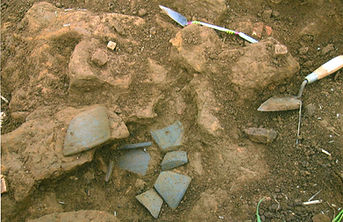
A broken pottery urn discovered at the FLAG dig in 2004.
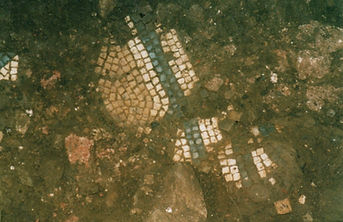
Part of a mosaic floor discovered during the FLAG dig in 2004.
Photos above courtesy of GMHG member, Cathy Lawrance, who took part in the 2004 FLAG dig.
In 2020, Rupert Birtwistle of Past to Present Archaeology began a project to re-examine the Roman villa at Goadby. Work commenced in October with a new geophysics survey of the site and a crowdfunding project was initiated in order to finance future excavations.

